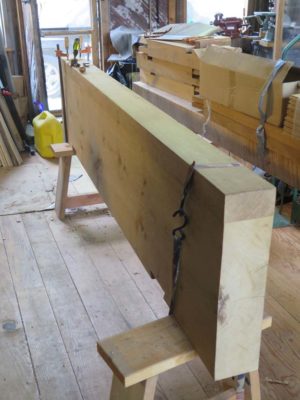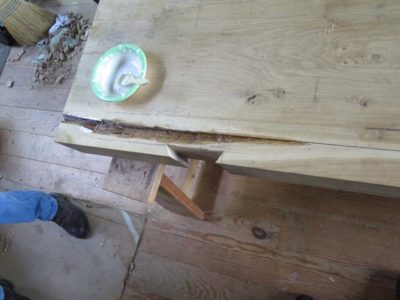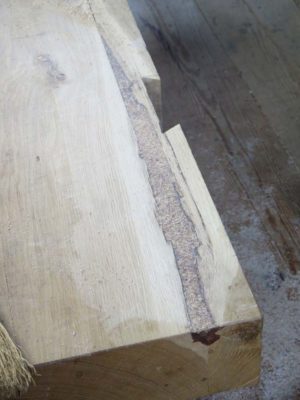Repairing the Underside of the FORP Bench

With a little logistical cogitation John and I, both 60-somethings and neither of us mesomorphs, managed to maneuver the 300+ pound top of the French Oak Roubo Project workbench out into the light. Immediately I was struck by both the magnificence of the 240(?) year old white oak slab, and the waney void adjacent to a glue line on the underside of it. I suppose at one time I was just going to leave it as-is, an admittedly foggy memory going back four years, but given that one of the leg mortises needed to go right through the flawed region I decided instead to fill it. I could have grafted in another piece of oak but instead fell back on a tried-and-true method of repair that I have employed several times in the past as it was especially well suited for a repair of this size.

I first sized (primed) the margins of the effected area with standard West System epoxy, thinned about 25% with acetone to get deep penetration. One of the reasons for any potential epoxy failures, whether in adhesion, consolidation or filling, is that the epoxy does not penetrate adequately to knit the entire construct together nicely. What then often happens also is that the density differences between the high density inelastic epoxy and the less dense, much more elastic wood, may result in a fracture at their margin when they are intimately bound together in a cyclic stressful environment. The diluted epoxy addresses the first of these problems, the filling of epoxy with large wood flakes addresses the second.


In this case I ran a scrap of oak through the power planer to yield the typically large shavings you would expect from the machine. I took handfuls of these shavings and packed them down into the void that had been previously primed with the thinned epoxy.

I then drizzled un-thinned epoxy on top of the wood flakes, then sprinkled on more shavings and packed them again through some wax paper. I let the entire fill to harden overnight.
An additional feature of fills like this is that when the volume is large enough, the exothermic reaction of the epoxy hardening causes the adhesive to actually boil in place, aerating the fluid as it hardens, reducing further the density of the hardened fill. This is a very good thing.


The resulting repair is much closer in density to the wood, thus reducing the risk of a system fracture at their interface, and yields a repair that can be easily smoothed with a rasp or Surform tool.
The success of the repair can be clearly seen in the edges of the mortises I drilled and pounded through the slab and the repair (next blog post). It held together wonderfully and had working properties nearly identical to the adjacent oak.



Join the Conversation!